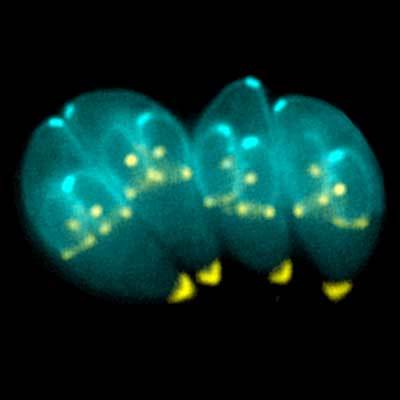Toxoplasma gondii - Wiki Toxoplasma gondii
From Wikipedia, the free encyclopedia
[Photo] T. gondii constructing daughter scaffolds within the mother cell. Source: http://pathogens.plosjournals.org/perlserv/?request=cover-legend&volume=2&issue=2 Toxoplasma gondii, an obligate intracellular human parasite, has a unique cytoskeletal apparatus that is probably used for invading host cells and for parasite replication. Shown here are images of T. gondii constructing daughter scaffolds within the mother cell. Cyan: YFP-α-Tubulin; yellow: mRFP-TgMORN1 (Hu et al.). Credit: Image provided by Ke Hu and John Murray. DOI: 10.1371/journal.ppat.0020020.g001
Toxoplasma is a genus of parasitic protozoa whose definitive host is cats but which can be carried by the vast majority of warm-blooded animals, including humans. Toxoplasmosis, the disease it causes, is usually minor and self-limiting but can have serious or even fatal effects on a fetus whose mother first contracts the disease during pregnancy or on an immunocompromised human or cat. It belongs to the phylum Apicomplexa and Toxoplasma gondii is the only known member species of the genus Toxoplasma.
Life cycle
The life cycle of Toxoplasma gondii has two phases. The sexual part of the life cycle takes place only in members of the Felidae family (domestic and wild cats), which makes these animals the parasite's primary host. The asexual part of the life cycle can take place in any warm-blooded animal, like other mammals (including felines) and birds.
In these intermediate hosts, the parasite invades cells, forming intracellular so-called parasitophorous vacuoles containing bradyzoites, the slowly replicating form of the parasite[1]. Vacuoles form tissue cysts mainly within the muscles and brain. Since they are within cells, the host's immune system does not detect these cysts. Resistance to antibiotics varies, but the cysts are very difficult to eradicate entirely. Within these vacuoles T. gondii propagates by a series of binary fissions until the infected cell eventually bursts and tachyzoites are released. Tachyzoites are the motile, asexually reproducing form of the parasite. Unlike the bradyzoites, the free tachyzoites are usually efficiently cleared by the host's immune response, although some manage to infect cells and form bradyzoites, thus maintaining the infection.
Tissue cysts are ingested by a cat (e.g., by feeding on an infected mouse). The cysts survive passage through the stomach of the cat and the parasites infect epithelial cells of the small intestine where they undergo sexual reproduction and oocyst formation. Oocysts are shed with the feces. Animals and humans that ingest oocysts (e.g., by eating unwashed vegetables etc.) or tissue cysts in improperly cooked meat become infected. The parasite enters macrophages in the intestinal lining and is distributed via the blood stream throughout the body.
Acute stage toxoplasma infections can be asymptomatic, but often gives flu-like symptoms in the early acute stages, and like flu can become, in very rare cases, fatal. The acute stage fades in a few days to months, leading to the latent stage. Latent infection is normally asymptomatic; however, in the case of immunocompromised patients (such as those infected with HIV or transplant recipients on immunosuppressive therapy), toxoplasmosis can develop. The most notable manifestation of toxoplasmosis in immunocompromised patients is toxoplasmic encephalitis, which can be deadly. If infection with T. gondii occurs for the first time during pregnancy, the parasite can cross the placenta, possibly leading to hydrocephalus, intracranial calcification, and chorioretinitis, with the possibility of spontaneous abortion or intrauterine death.
Behavioral modifications of the host
It has been found that the parasite has the ability to change the behavior of its host: infected rats and mice are less fearful of cats; in fact, some of the infected rats seek out cat-urine-marked areas. This effect is advantageous to the parasite, which will be able to sexually reproduce if its host is eaten by a cat[2]. The mechanism for this change is not completely understood, but there is evidence that toxoplasmosis infection raises dopamine levels in infected mice.
...
http://en.wikipedia.org/wiki/Toxoplasma_gondii
| The text in this page is based on the copyrighted Wikipedia article shown in above URL. It is used under the GNU Free Documentation License. You may redistribute it, verbatim or modified, providing that you comply with the terms of the GFDL. |
